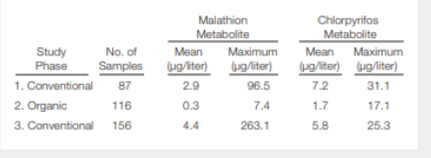
Concept explainers
Pesticide Residues in Urine To carry the USDA’s organic label (right), food must be produced without synthetic pesticides that farmers often use on conventionally grown, fruits, vegetables, and many grains.
Chensheng Lu of Emory University used urine testing to see whether eating organic food has a significant effect on the levels of pesticides in children's bodies (FIGURE 40.11). Over the course of 15 days, Lu and his colleagues collected the urine of 23 children (aged 3 to 11) and tested it for breakdown products of two synthetic pesticides. The children ate their normal diet of conventionally grown foods for three days, switched to organic versions of the same foods and drinks for five days, then returned to their convention.al diet for a week


FIGURE 40.11 Concentrations of metabolites of two pesticides (malathion and chlorpyrifos) in children’s urine during the three different phases of the study. The difference in the mean level of metabolites between the organic and conventional phases of the study was statistically significant.
During which phase of the experiment did the children's urine contain the lowest level of the malathion metabolite?
To determine: The phase of the experiment in which children’s urine contains the lowest level of the malathion metabolite.
Concept introduction: Conventionally, the fruits, vegetables, and grains are produced in which pesticides are used. Pesticides such as malathion and chlorpyrifos are neurotoxicant. At the high level, it works by inhibiting acetylcholinesterase. This can lead to paralysis, breathing problem, and even death. Due to its toxic effect, the fruits and vegetable are produced through organic farming without the use of pesticides and gain the label of USDA’s organic label.
Explanation of Solution
The study was performed to assess the effect of eating organic food on the level of pesticides in children’s bodies. The urine samples were collected over the course of 15 days from 23 children aged between 3 to 11years. The samples were tested for the breakdown products of two synthetic pesticides malathion and chlorpyrifos. The study was conducted in three phases. In first phase conventional food was given for 3 days, then the organic food for 5 days, and again conventional food for one week.
Refer to Fig. 40.11 “concentration of metabolites of two pesticides in children’s urine” in the question; the second (organic) phase of the experiment contains mean malathion value of 0.3 µg/liter which is lower than the first phase (conventional phase, 2.9 µg/liter) and the third phase (conventional phase, 4.4 µg/liter) of the mean value. Therefore, in the second phase of the experiment, children’s urine contains the lowest level of the malathion metabolite.
The urine during phase two, when ingesting an organic diet, contained the lowest level of metabolite.
Want to see more full solutions like this?
Chapter 40 Solutions
Biology: The Unity and Diversity of Life (MindTap Course List)
Additional Science Textbook Solutions
Laboratory Manual For Human Anatomy & Physiology
Genetics: From Genes to Genomes
Campbell Essential Biology (7th Edition)
HUMAN ANATOMY
Chemistry: A Molecular Approach (4th Edition)
Organic Chemistry (8th Edition)
- 1. In the following illustration of a phospholipid... (Chemistry Primer and Video 2-2, 2-3 and 2-5) a. Label which chains contain saturated fatty acids and non-saturated fatty acids. b. Label all the areas where the following bonds could form with other molecules which are not shown. i. Hydrogen bonds ii. Ionic Bonds iii. Hydrophobic Interactions 12-6 HICIH HICIH HICHH HICHH HICIH OHHHHHHHHHHHHHHHHH C-C-C-C-C-c-c-c-c-c-c-c-c-c-c-c-C-C-H HH H H H H H H H H H H H H H H H H H HO H-C-O H-C-O- O O-P-O-C-H H T HICIH HICIH HICIH HICIH HHHHHHH HICIH HICIH HICIH 0=C HIC -C-C-C-C-C-C-C-C-CC-C-C-C-C-C-C-C-C-H HHHHHHHHH IIIIIIII HHHHHHHH (e-osbiv)arrow_forwardAnswer this as a dental assistant studentarrow_forwardbuatkan judul skripsi tentang parasitologi yang sedang trendinharrow_forward
- Dental assistantarrow_forwardO Macmillan Learning Glu-His-Trp-Ser-Gly-Leu-Arg-Pro-Gly The pKa values for the peptide's side chains, terminal amino groups, and carboxyl groups are provided in the table. Amino acid Amino pKa Carboxyl pKa Side-chain pKa glutamate 9.60 2.34 histidine 9.17 1.82 4.25 6.00 tryptophan 9.39 2.38 serine 9.15 2.21 glycine 9.60 2.34 leucine 9.60 2.36 arginine 9.04 2.17 12.48 proline 10.96 1.99 Calculate the net charge of the molecule at pH 3. net charge at pH 3: Calculate the net charge of the molecule at pH 8. net charge at pH 8: Calculate the net charge of the molecule at pH 11. net charge at pH 11: Estimate the isoelectric point (pl) for this peptide. pl:arrow_forwardBiology Questionarrow_forward
- This entire structure (Pinus pollen cone) using lifecycle terminology is called what?arrow_forwardThis entire structure using lifecycle terminology is called what? megastrobilus microstrobilus megasporophyll microsporophyll microsporangium megasporangium none of thesearrow_forwardHow much protein should Sarah add to her diet if she gets pregnant? Sarah's protein requirements during pregnancy would be higher. See Hint B2. During calculations, use numbers rounded to the first decimal place. In your answer, round the number of grams to the nearest whole number. _______ g ?arrow_forward
- C MasteringHealth MasteringNu X session.healthandnutrition-mastering.pearson.com/myct/itemView?assignment ProblemID=17396422&attemptNo=1&offset=prevarrow_forwardMost people, even those who exercise regularly at low to average intensity (1 hour at the gym or a 2- to 3-mile walk several times per week), do not need an increased protein intake. What would be the protein needs of a man named Josh who exercises moderately and is the same age and size as Wayne? Josh is 5 ft, 8 in tall and weighs 183 lb. Round the number of grams to the nearest whole number. During calculations, use numbers rounded to the first decimal place. Because protein requirement is a range, please enter two numbers: lower and upper range values, respectively. Separate the lower and upper range values, in that order, by a comma. ___, ___ g ?arrow_forwardC MasteringHealth MasteringNu X session.healthandnutrition-mastering.pearson.com/myct/itemView?assignment ProblemID=17396422&attemptNo=1&offset=prevarrow_forwardarrow_back_iosSEE MORE QUESTIONSarrow_forward_iosRecommended textbooks for you
